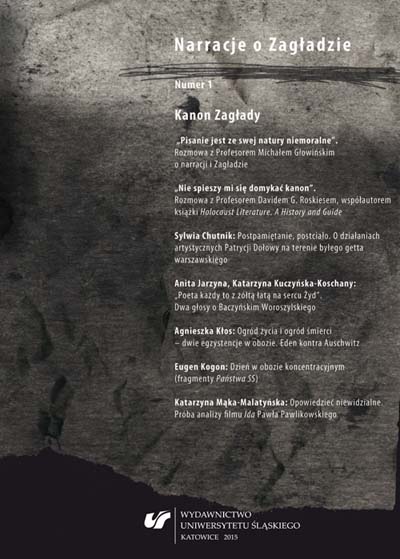Recenzje: (Pop)Historie polskich emisariuszy. Komiksy. "Kurier z Warszawy". Scen. M. Urbanek i M. Palka. Rys. B. Stefanowicz (...) "Jan Karski. Człowiek, który odkrył Holokaust". Scen. M. Rizzo. Rys. L. Bonaccorso. Przeł. A. Hołub...
Reviews: Pop(Histories) of Polish emissaries. Comic books. "Kurier z Warszawy". Scen. M. Urbanek i M. Palka. Rys. B. Stefanowicz (...) "Jan Karski. Człowiek, który odkrył Holokaust". Scen. M. Rizzo. Rys. L. Bonaccorso. Przeł. A. Hołub...
Author(s): Krzysztof LichtblauSubject(s): Language and Literature Studies, Studies of Literature, History of the Holocaust, Book-Review
Published by: Wydawnictwo Uniwersytetu Śląskiego
Summary/Abstract: The review is devoted to two comic books about Polish emissaries who were active during the Second World War. The first one, "Kurier z Warszawy" by Mariusz Urbanek, Mateusz Palka (script) and Bartłomiej Stefanowicz (drawings), is the history of Jan Nowak-Jeziorański’s mission since 15 September 1939, when the latter was already on the front line, until the press conference with the journalists held in the Ministry of Information of Great Britain in 1945. The second one, "Jan Karski. Człowiek, który odkrył Holokaust", is the work of Italian artists: Marco Rizzo (script) and Lelio Bonaccorso (drawings). From this comic book we also learn about the tasks performed by the Polish war emissary, Jan Karski, until he reaches the United States and makes an account about the state in which his fatherland found itself. In both cases the authors used the memoirs of the emissaries which were published in book form. The aim of the review is to direct the reader’s attention to the changes which occur during the adaptation of such sources to comic books. One of such elements includes the introduction of images and the transposition of the narration from the verbal to the graphical plane. Another important category which is used in the review is the representativeness of the narration of testimony. The entirety of the considerations is summarised by a remark about the transformations of the contemporary comic books about the Holocaust and the location of the comic books which are discussed in this area.
Journal: Narracje o Zagładzie
- Issue Year: 2015
- Issue No: 1
- Page Range: 329-337
- Page Count: 9
- Language: Polish

